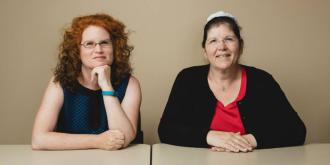
Kate Sharron and Patrice Wheeler of Cal State Northridge work to provide accessibility to all students.
Photo Credit: EdTech Magazine
"For students with disabilities — whether related to sight, cognition or dexterity — digitization in higher education curricula can create significant challenges. In some cases, students and advocacy organizations have filed complaints and lawsuits against colleges that fail to comply with the Americans with Disabilities Act and with Section 508 of the Rehabilitation Act of 1973, mandates requiring federally funded institutions to ensure all individuals with disabilities can use online content as effectively as other individuals.
The World Wide Web Consortium’s Web Content Accessibility Guidelines advocate for all digital content to be perceivable, operable, understandable and robust. Many institutions, including the 23-campus California State University system, are embracing these and other strategies to make accessibility a top priority.
Teach the Teachers for Better Outcomes
Kate Sharron, program manager of California State University, Northridge’s Universal Design Center, says the center strives “to educate the campus community so they incorporate accessibility considerations into their everyday work.”
The university has an Accessible Technology Initiative and a procurement process that calls for staff to evaluate products for accessibility before making a purchasing decision.
According to Rima Maldonado, a reading/alternate media services coordinator at Cal State Fresno, such efforts are essential. When students with disabilities lack user-friendly materials, they may fall behind in course work, feel isolated from class discussions and struggle to succeed in their programs."
Read more at EdTech
